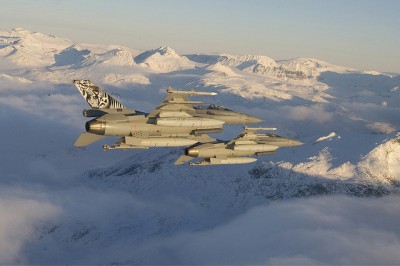As Norwegian politicians try to balance their indignation and concerns over Russia’s territorial takeover in Crimea with their desire to remain good neighbours, Russian fighter jets continue to fly up and down along Norway’s own territorial border off the northwest coast. The regular flights seem aimed at asserting Russia’s growing military presence in the important and resource-rich Arctic, while Norwegian leaders seem intent on avoiding provocation.

Newspaper Aftenposten reported on Wednesday that the Russian fighter jet flights have been occurring on a weekly basis, with between 50 and 90 registered every year since 2009 according to numbers from the Norwegian military’s operational headquarters. The Russian pilots stay just outside the so-called 12-mile zone, or roughly 22 kilometers offshore, and usually fly from north to south, often turning around over the scenic archipelago of Lofoten.
They’re not out on sightseeing excursions, though, with military officials believing the missions are fueled by a need for pilot training and to simply show off. Russia, led by a president whom an Aftenposten commentator described as a “czar” on Wednesday, seems to feel a need to remind both Norway and NATO that they are a military power to be reckoned with.
Eyeballing each other
The Norwegian military responds to every flight by sending its own F16 jet fighters up to “greet” the Russians, and remind them in turn where the border lies. “We fly so close to each other that we can wave at them,” said Arvid Halvorsen, chief of an air surveillance station at Mågerø outside Tønsberg on the other end of the country. He told Aftenposten that “we fly right up to the Russian jets, show the flag and look them in the eyes” before the Russians fly off again. It’s important, he noted, for Norway to mark its sovereignty as well.
During the Cold War, Norway and NATO registered hundreds of such flights a year, but they tapered off dramatically when the Soviet Union broke apart in the early 1990s. The flights started to take off again around 2000, not coincidentally when Vladimir Putin assumed power in Russia and was willing to spend money on increased military activity.
Today the Russian military presence and visibility in what the Norwegians call nordområdene (literally, “the northern areas”) is stronger than it’s been in many years. Aftenposten reported that the military build-up is in line with the melting ice that’s opening up new transport opportunities and easier access to resources, both oil, gas and fish.
Concerns for trouble ahead
Conflicts may loom over claims to such resources, even though Russia surprisingly signed a territorial agreement with Norway in the Barents Sea just a few years ago. Norwegian politicians decrying Putin’s lack of respect for territorial borders in Crimea are concerned that a similar lack of respect may be shown in the Arctic, but face a major dilemma over what to do about it. Putin urged his captive audience in Moscow on Tuesday not to believe “those who say other regions will follow after Crimea. We don’t want to split up Ukraine.” His track record and nationalist fervor suggests otherwise, however, and Aftenposten ominously noted that Russia has never fully accepted Svalbard as belonging to Norway, for example. Russia maintains a population of around 400 mineworkers at Barentsburg on Svalbard — 100 Russians and, ironically, 300 Ukrainians. Concerns are growing that Russia suddenly may feel a need to “protect” them like they “protected” Russians in Crimea, and simply take over.
Svalbard’s local Norwegian governor claims there is “good chemistry” between the Russians and the Norwegians on Svalbard and he told Aftenposten that he wants to leave political issues to the leaders in Moscow and Oslo. On Tuesday, members of the Norwegian Parliament in Oslo seemed to prefer keeping a relatively low profile when they received a briefing on Russia’s annexation of Crimea and the Ukrainian crisis that sets off from Foreign Minister Børge Brende.

Brende faced no opposition to the Norwegian government’s plans to impose the same sanctions against Russia that the EU and US have put forward. Newspaper Dagsavisen reported that no Norwegian Member of Parliament expressed disagreement with the strongest Norwegian reaction against Russia since the Cold War. Norway’s top politicians clearly believe that Norway of course must “condemn” violations of international law and the lack of territorial respect shown by Putin.
At the same time, however, the Norwegian politicians don’t seem to want to be overly blatant about that, or even adopt a milder response than that of its European allies. Either could attract more unwanted attention in Moscow, noted Dagsavisen. While Brende has adopted much of the EU’s and US’ rhetoric, Norway has also been careful to, for example, appear in Kiev with Finland instead of Sweden, whose foreign minister Carl Bildt has been much tougher, even calling Ukraine’s ousted president a “Quisling.”
The Norwegian leaders also saw no need for a full public debate over Norway’s position on Russia’s annexation of Crimea on the floor of Parliament this week. They were satisfied merely with Brende’s briefing, reported Dagsavisen, possibly because such a debate could also attract too much attention from Moscow. Brende is scheduled to deliver the foreign minister’s annual foreign policy address to parliament next week, though, and he’ll need to address the issue.
Until then, Norwegian leaders have chosen to follow the EU’s and US’ lead, which was likely expected in Moscow. Norway thus can try to maintain its delicate balance with Russia and continue to “greet” its fighter jets buzzing the Norwegian coast. Relations ultimately lie in the hands of NATO and EU leaders, though, and may sour if and when Norway is called upon, for example, to boost gas production to help offset any disruptions or outright boycotts of Russian gas deliveries.
newsinenglish.no/Nina Berglund

